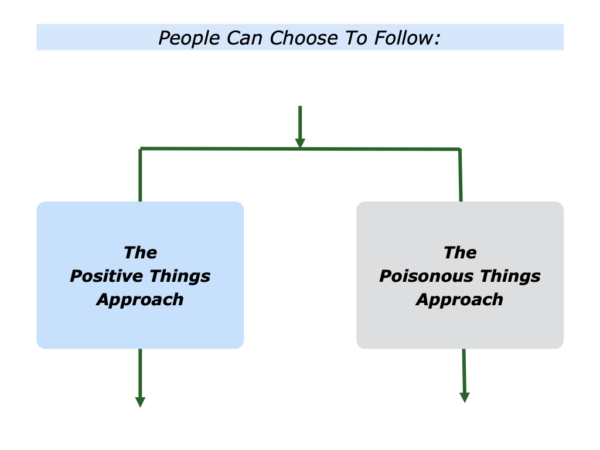
There are many ways to live life. The route that people follow can have consequences for both themselves and other people.
Some people follow the positive things approach. They aim to be positive, spend time with positive people and do positive things in their life and work. This can have beneficial effects for themselves and other people.
Some people follow the poisonous things approach. They behave in ways that spread animosity, cause pain and hurt others. They may feel justified but this can have negative effects for other people.
Some people follow the positive things approach but also find ways to deal with poison. They aim to do practical things that can help rather than hurt themselves and other people.
Some people take a similar step to reclaim their lives after spending time in a poisonous environment. They choose to do things that give them positive energy. They are then more able to heal themselves and help other people.
Different people choose to follow these different routes in different ways. Let’s explore these themes.
The Positive Things Approach
Some people learn to follow this approach early in their lives. They may grow up in a family where they are given love, encouragement and the chance to be themselves.
This is a pattern followed by many people who may have had difficulty in school. They may have been dyslexic, had ADHD or been seen as slow learners. They report that their parents aimed:
To give them support … To build on their strengths … To find ways to manage school whilst doing stimulating things on the side that helped them to achieve success.
Such people learn to follow similar principles in their relationships. They have a positive attitude and encourage people. They also spend time with people who have similar approach.
They may aim do work that gives them positive energy. Some people follow this path early in their working lives. Some transition to this approach later in their careers.
Some individuals also learn to recognise warning signs if others try to fight dirty. They may learn to do this in their early adult years. Some may learn it later after spending years trying to change other people.
People who take the positive things approach sometimes follow the philosophy that everything is food. Let’s explore this theme.
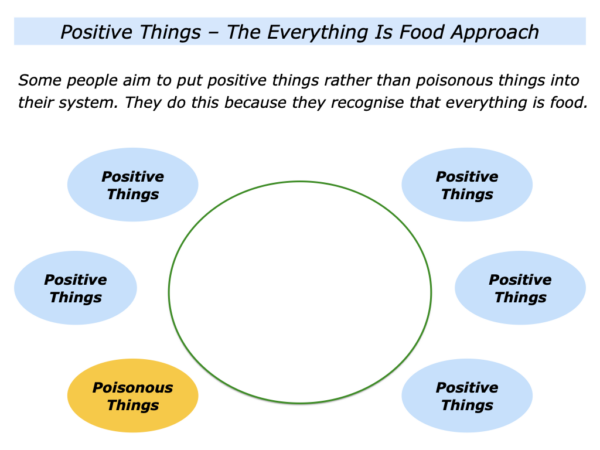
Everything is food. The things we encounter each day have the ability to affect our system. These may be sounds, sights, people and the things we choose to focus on. What we do about these experiences is, of course, up to us.
Positive Food
One person described becoming aware of the experiences they were exposing themselves to in the following way.
“My Eureka moment came one morning on the Motorway. Sitting in the traffic jam listening to politicians arguing on the radio, I found myself getting more depressed.
“So I switched off the radio, put on my favourite music and let my mind wander. It didn’t shift the traffic, but something changed within me.
“Now I start the day by listening to music, rather than arguments.
Instead of ‘garbage in, garbage out’, I go for ‘good things in, good things out’.”
What is the positive food that you put into your system? You may choose, for example, to do some of the following things.
Be with encouraging people … Do stimulating work … Listen to your favourite music … Eat healthy food … Spend time in the countryside … Surround yourself with beauty … Pursue creative activities – such as writing, gardening, painting or whatever … Set aside time to reflect.
Poisonous Food
Is there any poisonous food that you experience in your life or work?
What are the negative things that affect your system? You may choose, for example, to do some of the following things.
Listen to negative people … Eat tasteless food in hotels … Spend too many nights away from home … Work with dispiriting clients … Have back-to-back meetings during the day … Meet in windowless rooms … Feel out of control at work … Neglect your health.
There are many kinds of food that affect our systems. The old rule applies: “What we focus on, we become.”
People can choose to study many of the positive things happening around the world, for example, rather than listen to a constant diet of bad news put out by the traditional media.
They can study the work done by social enterprises to tackle some of humanity’s most pressing problems. These include organisations such as Ashoka, Acumen Fund, Skoll Foundation, Echoing Green and Schwab Foundation.
They can study the many educational projects that are helping young people to develop Twenty-First Century Skills. These skills include Clear Thinking, Creativity, Collaboration and Communication. Studying these is more uplifting than complaining about schools still geared to the Industrial Age.
People who aim to stay healthy often follow the approach described by Barbara Fredrickson. Let’s explore this approach.
Barbara Fredrickson’s
Work On Positivity
Barbara did pioneering work that demonstrated how positive emotions can improve our lives. Twenty years of research into emotions culminated in her book Positivity. Here is the key theme she highlighted.
People who have positive emotions in a ratio of 3:1 in relation to negative emotions are more likely to flourish.
Barbara saw this pattern repeated in marriages and teams that thrived. People who experienced more negativity were more likely to have difficulties.
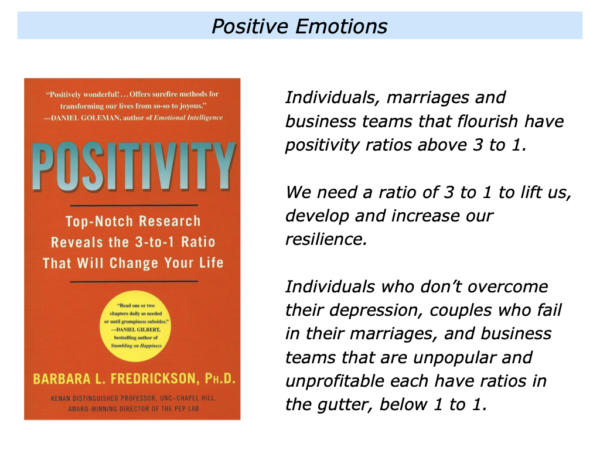
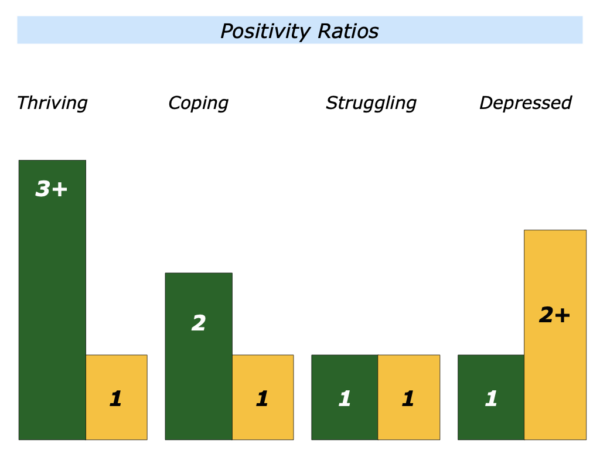
Barbara explains that positivity is more than simply being happy. It certainly isn’t putting on a smiling face to grin and bear things.
Positivity is based on being true to ourselves. It embodies gratitude, love, playfulness, curiosity and adventure. These emotions trigger each other and create an upward spiral. They ‘broaden and build’, helping us to make breakthroughs and bring new things into being.
Such emotions provide the basis for creativity, problem solving and even evolution. They enable us to open our hearts and minds. Negativity, on the other hand, closes down our ability to think, create and grow. Barbara explains this in the following way.
Positivity consists of the whole range of positive emotions – from appreciation to love, from amusement to joy, from hope to gratitude, and then some.
Barbara discovered that people could improve their wellbeing by improving their positivity ratio. She likened this to changing their diet to eat healthier food. They needed maintain this positive diet, however, rather than keep exposing themselves to negativity.
She listed ten forms of positivity that can nourish the soul. People can do both simple and big things that generate the following emotions in themselves and other people.
Gratitude … Joy … Love … Hope … Inspiration … Amusement … Awe … Interest … Pride … Serenity.
People who maintain these habits will create an upward spiral that takes them beyond the tipping point. They are then more likely to increase the wellbeing of both themselves and other people.
People who follow the positive things approach often aim to feel grateful, generous and to help other people. They are also more likely to experience a sense of peace.
The Poisonous Things Approach
Some people follow the poisonous things approach. They behave in ways that spread animosity, cause pain and hurt others. They may feel justified but this can have negative effects for other people.
Some people learn to follow this approach early in their lives. They may grow up in a family that is painful. They may have been denied love, stability and the chance to grow in a positive way.
Such individuals may then aim to feel in control by being narcistic or hurting others. They may seek conflict, scapegoat people who are different or find other ways to feel superior. They spread poison rather than positivity.
Let’s return to your own life. Imagine that you want to be positive and do positive things in your time on the planet. How can you follow these approach in your own way?
If you wish, try tackling the exercise on this theme. This invites you to complete the following sentences.
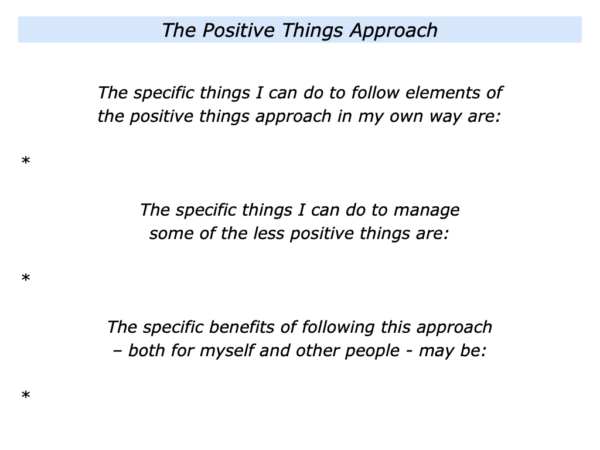


Leave a Reply